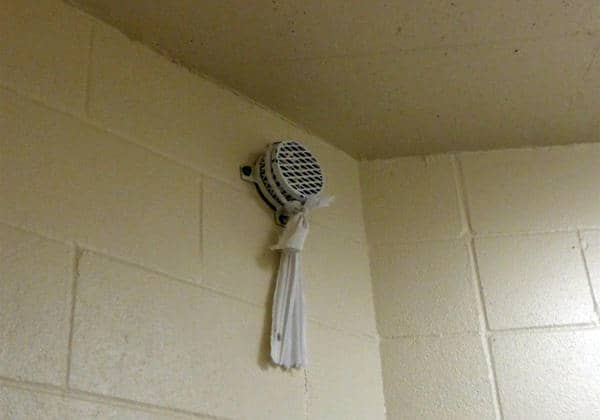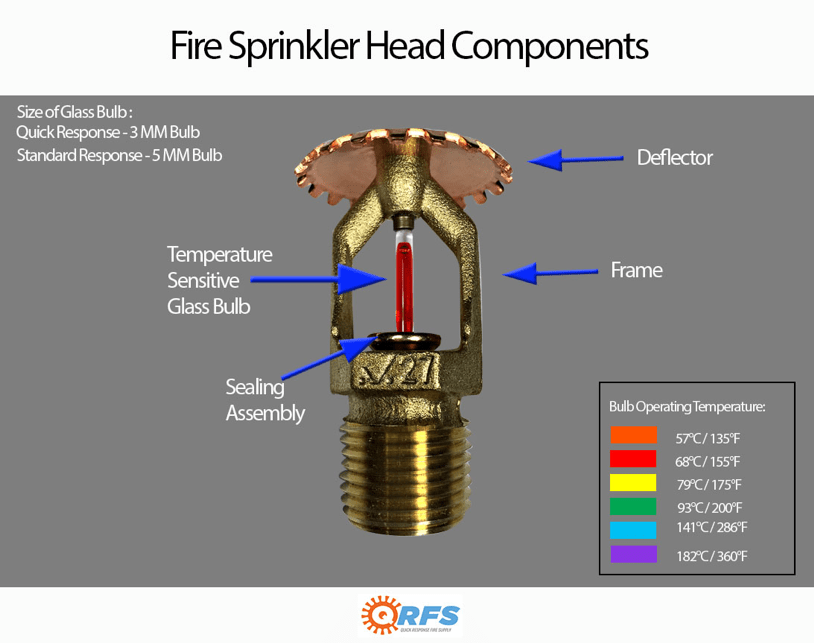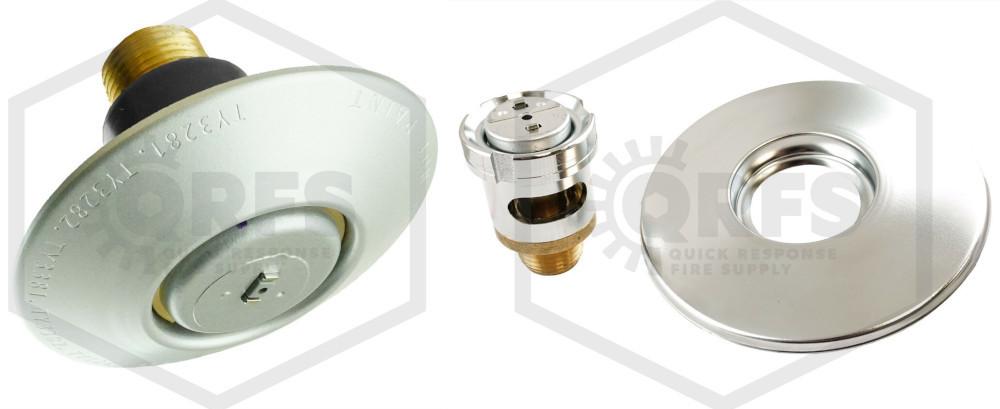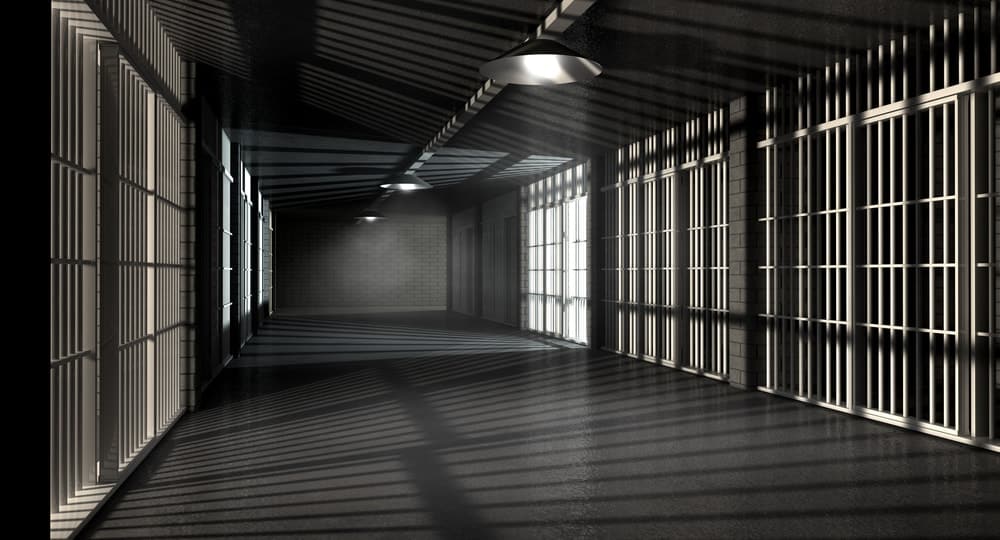Tamper-resistant fire sprinklers can mitigate arson, suicides, vandalism, and costly lawsuits
Fire sprinklers that activate when they shouldn’t have been known to cause upwards of $100,000 in damage. And in some environments, these discharges don’t happen by accident. In a prison, jail, mental health facility, or any other place where people are confined, motives from boredom to self-harm can transform the average fire sprinkler into an expensive and potentially dangerous liability. Institutional fire sprinklers, also known as tamper-resistant fire sprinklers, are manufactured with these concerns in mind. They meet the same fire protection standards as normal sprinklers while providing safeguards against damage and misuse.
Check out QRFS’s selection of institutional sprinklers, replacement institutional escutcheons, and compatible wrenches and escutcheon installation tools. If you buy or have institutional sprinklers, it’s also wise to keep an Institutional Shutgun on hand to ensure fast water stoppage if the sprinklers activate unintentionally.
Correctional facilities have substantial fire protection needs
Tamper-resistant automatic fire protection systems are essential in correctional facilities, as locked-up inmates are often helpless if a system fails — or worse, a facility doesn’t have one at all.
A 2002 fire at the Mitchell County Jail in Bakersville, NC remained a vivid memory for surviving inmate O.M. Ledford Jr. 14 years later.
“In 10 minutes, the smoke started coming in,” he said in a 2016 interview with ABC-13 WLOS. “We didn’t know what was going on. We was upstairs. Everybody started beating on the walls, hands against the bars. At first, everybody was cussin’, raising Cain, but after that, it was like the worst, scariest show you ever seen.” Ledford “said he watched as seven other inmates serving with him on the second floor of the jail behind the old courthouse died.”
A total of eight people died in the fire. The cause was never officially determined, though Ledford suspects he knows who started it.
Other fires in correctional facilities have been deadlier. A fire originating in an isolation cell in a non-sprinklered jail in Biloxi, Mississippi killed 29 people in 1982; 42 died in a Maury County, Tennessee jail in 1977 when a cigarette ignited the padding in a cell; and the deadliest prison fire in US history happened in the Ohio State Correctional Facility back in 1930: 320 inmates were killed and 133 others were injured in the Columbus, Ohio prison.
Fortunately, the number of reported prison and jail fires has fallen dramatically in recent decades, declining from more than 4,000 in 1980 to less than 1,000 by the early 2000s.
Data from a 2010 report by the National Fire Protection Association suggests that, in many ways, fires in these facilities happen in the usual places. Kitchens, in the home or in lock-up, are the top cause of fires.
One figure from that report complicates this picture: Nearly one in four fires in prisons and jails were intentionally set. And while these facilities tend to have far fewer flammable materials than other structures, the smoke inhalation caused by any fire remains just as if not more deadly.
Fire sprinklers, the first line of defense, are targets for vandalism
A cocktail of boredom, isolation, and criminality leads to recurring vandalism in prisons—and the issues don’t stop at setting fires. Tampering with fire sprinklers is also widespread.
Local news coverage chronicles a long list of tampering incidents in Indiana, Pennsylvania, North Carolina, and a host of other states. In 2010, New Hanover County, NC reported losses of more than $42,000 annually from intentionally damaged sprinklers.
In 2015, an inmate caused flooding in the newly constructed, $150-million Orleans Parish Prison. The The New Orleans Advocate reported that the city jail for New Orleans, Louisiana, was damaged when the inmate pried the sprinkler cap in his cell off, pouring water throughout the facility’s second floor.
Similar incidents took place at the Green Street Cell Block—Newark, New Jersey’s municipal jail—where inmates broke four sprinklers in just three months.
Extruding fire sprinklers can become an accessory to self-harm
Precautions against fire sprinkler vandalism are necessary, but some have backfired with tragic consequences. Between 2014 and 2015, Washington state’s prison systems experienced one of the highest suicide rates in the nation. Two of those deaths and at least one attempt happened when inmates hung themselves from holes in the cages covering fire sprinklers at a prison in the small town of Airway Heights.

The political, emotional, and financial costs of prison suicides can be enormous. In 2014, New Jersey’s Green Street Cell Block was the subject of a Department of Justice report, which noted that every cell featured “suicide hazards such as exposed cross bars which could be used as hanging points.”
Seven of the eight suicides attempted in the 10 years preceding Green Street’s closure resulted in death, Newark’s Public Safety Director Anthony Ambrose said in an interview with NJTV News, and the resulting lawsuits from surviving family members cost the city millions.
The Bureau of Justice Statistics’ most recent summary of mortality rates in local jails indicates that 2014 saw 50 deaths per 100,000 inmates, the highest rate recorded since 2000. Although it can be difficult to prove that negligence by staff led to a suicide, a National Institute of Corrections report on jail suicides notes that juries have awarded amounts in excess of $1 million to the surviving family members of inmates who committed suicide.
The features of a safer fire sprinkler
Architect James Hunt and safety expert David Sine’s catalog of common mistakes in designing psychiatric hospitals warns that areas of the facility where patients are unsupervised or minimally supervised should be fitted with high ceilings and sprinkler heads that are “as vandal-resistant as possible.”
Pendent sprinklers, which protrude from the ceiling and have a bottle cap-like deflector at one end, exemplify what isn’t “vandal-resistant” about the average sprinkler. The glass bulb controlling water flow can easily be destroyed, a rope or other hanging implement can be threaded through the frame, and the deflector or other parts can be detached and used as weapons.

According to Viking, the Michigan-based manufacturer of fire sprinklers, an absolutely tamper-proof fire sprinkler isn’t possible. Nevertheless, in a 2006 technical article on fire sprinklers in correctional facilities, Viking’s Scott Martorano notes that while every fire sprinkler must have detachable parts—components that permit the flow of water through the sprinkler during a fire—tamper-resistant features can still do a lot of good.
Institutional sprinklers are designed with these features in mind. Escutcheons, which cover the hole where the sprinkler meets the wall, are specially secured, making it more difficult for anyone to fashion a weapon from detached sprinkler parts. The sprinkler’s detachable parts are also designed to fully release under weight limits of anywhere from 30 to 80 pounds and have either flat or cone-shaped bodies, both of which help prevent suicide by hanging. In addition, the activation components of these sprinklers are hidden behind a flush design.
Viking, Tyco, and Reliable design and manufacture of institutional sprinklers with tamper-resistant features. For a detailed rundown of their offerings read: “Comparing Tyco, Viking & Reliable Institutional Fire Sprinklers.”

Viking, Tyco Raven, and Reliable XL institutional sprinklers feature locking escutcheons and parts that detach under significant weight, and all of them mount flush to the wall or ceiling, striking a smart balance between fire protection, life safety, and efforts to curb vandalism.
Check out QRFS’s selection of institutional sprinklers, replacement institutional escutcheons, and compatible wrenches and escutcheon installation tools. And if you buy or have institutional sprinklers, it’s wise to keep an Institutional Shutgun on hand to ensure fast water stoppage if the sprinklers activate unintentionally.
If you need help placing an order or have any questions, contact QRFS at 888.361.6662 or support@qrfs.com.
This blog was originally posted at blog.qrfs.com. If this article helped you, check us out on X @QuickResponseFS.



I’d like to see if our jail facility could benefit from these devices. Could you please provide information on the Viking VK410 and Tyco Raven 5.6k?
Tijuana, thanks for commenting! Our QRFS Support Team will reach out to assist you. You can always reach us at support@qrfs.com or 888-361-6662.
Hi, Can I get a quote for 100 x tyco (institutional sprinkler) head.
best regards
Shahfik
Shahfik, thanks for reaching out. We will have someone from our QRFS Customer Support Team reach out.
I havent been able to find an institutional or behavioral health fire sprinkler that is FM Global approved. Am I missing something?
To our knowledge, Tyco, Reliable, and Viking institutional fire sprinklers are all cULus Listed for light and ordinary hazard applications. NFPA standards simply require listings, not that they are specifically listed by FM (FM Approved). So, unless you have some arguably onerous insurance requirement, it should not matter for compliance or the sprinkler’s performance.
Are these heads combatable in Australia ?
Paul — Yes, though depends on the model. You want to look for a sprinkler that is available in both NPT/inches (North America, etc.) and BSPT/mm (Commonwealth) versions.
These Viking institutional sprinklers, for example, come in BSPT-threaded models. You can find that information on a given product page or in a sprinkler’s data sheet. Thanks for reading!